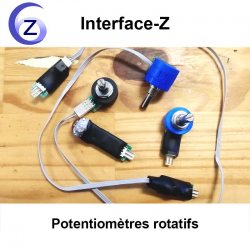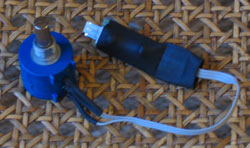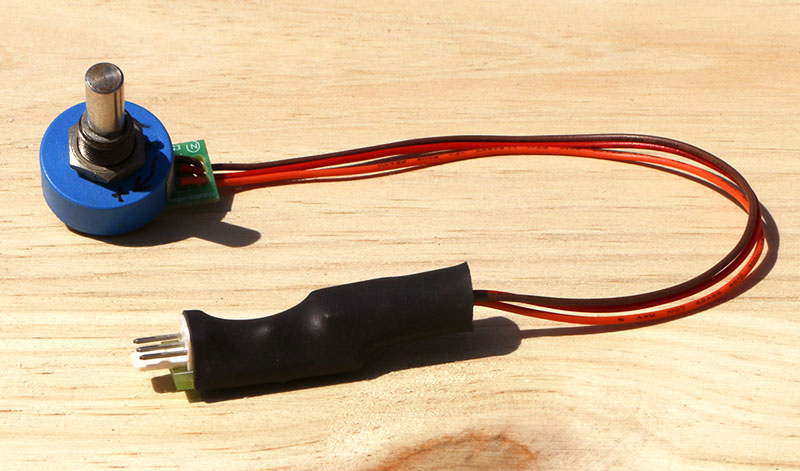











Potentiometers can be useful as sensors in various cases :
- to test a data acquisition system or the behavior of a program, it's a very simple and easy solution. One just needs to turn or slide the rod to change the signal ;
- as a sensor, a potentiometer can be connected or adapted to a moving mechanical system, and offer feedback on a rotation, twist or short distance movement. Many types of potentiometers exist, each more or less adapted for a specific measurement.
There is a multitude of different potentiometer types ; we supply multiple versions as shown below.
A rotary potentiometer is a rotation, position and angular movement sensor. It's possibilities for interactivity and events are varied : as a mechanical sensor, it can be stuck to a door hinge and give information on the opening on and closing of a door (and by extension, the passage through the door), it can be used to control video or sound effects. The potentiometer can also become a turning button or be linked to an object that a spectator moves... It is also useful for motor control, to know the position of the motor's axis.
The model we offer contains a flexible potentiometer and is used to manually simulate the behavior of a more complex analog detection. It's made up of an electronic adaptation and a 3 pin connector. Its complete range is attained in less than 1 full rotation. It can be plugged onto a « 2 analog inputs » or « 12 analog inputs » interface that can transform the analog data into a digital protocol such as Midi, DMX.

Simple, single-turn potentiometer sensor.
Data behavior : over its full range, the sensor data goes from 0 to maximum value of the protocol one is using, (0 to 127 for standard Midi, 0 to 4095 in high resolution).
This sensor is used in the same way as the one previously mentionned but over more turns meaning it can be used for bigger movements. It can integrated into objects that work with a limited amount of rotations. The electronic card can be separated from the potentiometer itself to help conceal it on a device or in an object.


Rotation over 10 consecutive turns
Data behavior : the data values evolve over 10 full rotations of the potentiometer's shaft, going from 0 to the maximum value at the end of the 10th turn. The maximum value depends on the protocol one is working with. In standard Midi : 127 is the maximum value.
This sensor is very useful for analyzing the movement of rotating elements such as wheels, crank handles, spinning stools, any device that can turn on itself indefinitely... Mounted on an object that has a rotating axis, it can be used to modulate video playback, sound, light effects. For example, letting a spectator fast forward, or rewind a projected video by manipulating a wheel or crank handle, depending on the rotation direction and rotation speed of the manipulated object.


Infinite rotation potentiometer sensor
Data behavior : over one full turn on itself, the data varies over its full range. However after one complete spin, the potentiometer shaft doesn't block itself, and can be turned again in the same direction, the data then resets to allow the full range, going from 0 to its maximum with each turn.
Another page is dedicated to Joysticks : here.
Il n'y a pas d'autres documents disponibles ici pour le moment.
You might also like